14
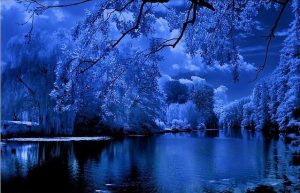
A poem is that species of composition, which is opposed to the works of science, by proposing for its immediate object pleasure, not truth; and from all other species (having this object in common with it) it is discriminated by proposing to itself such delight from the whole, as is compatible with a distinct gratification from each component part.
—S.T. Coleridge, Biographia Literaria, Chapter XIV
Poetry is the most important thing in the universe. It is the voice of the universe—the voice of God. Poems are the translation of that voice into words. God does not speak in words. But God is always speaking. God speaks in all things at all times for all people. But only some people can hear him. Those people are poets—or more broadly artists. The job of the poet is therefore to translate God’s voice into words for those of us (the vast majority) who can’t hear it.
This is pretty much what you believe if you are a Romantic poet. You are special. You have a gift that sets you above ordinary people, the gift of perceiving and then transferring the voice of God (but Romantics prefer the word “Nature”) in the natural world as well as the gift of translating that sound so we ordinary people can have a sense of it.
How do you know you’re “hearing” the voice of the divine? You know it from the pleasure it gives you. As you will remember from our discussion of the Ode, Romantic poet William Wordsworth said:
There was a time when meadow, grove, and stream,
The earth, and every common sight,
To me did seem
Appareled in celestial light,
The glory and the freshness of a dream.
God speaks in and through Nature. We are part of Nature. But unless we are a poet we get only a dim sense of the divine voice. The poet gets a strong sense, puts what he hears (“feels” becomes “hears” in the translation of the poet), and amplifies our response by writing a poem that we read with pleasure and recognition.
This idea will be presented in many images this week in the poems we’ll read.
First a warning: In the sense we are using it, the word “Romantic” has nothing to do with love. It does not suggest hearts and flowers and boxes of chocolates and evenings around the fireplace with champagne. You have to forget all that. Applied to poetry—and to art and to all the creative and philosophical productions of the late 18th and most of the 19th centuries—known as the “Romantic Era”—it has no specific association with love. It is associated with feeling or emotion, in particular with the feelings and emotions you experience in response to the universe (which is to say “nature”) or to art, but not what we call romantic love.
“Romantic” signifies a movement from a primary trust in reason (of the Age of Enlightenment) to a primary trust in feeling as a path to truth.
Romance and Science: Scientific knowledge is perfectly valid. Science can prove certain things to be true. But its focus is on physical reality. It can determine the speed of light and the rate of global warming. But it can’t say much about the deepest truths about God and Nature.
At the same time, science, even when saying things true, can draw us away from what matters. Romantic poet John Keats famously wrote this (using the word “philosophy” as a synonym for “science”):
Do not all charms fly
At the mere touch of cold philosophy?
There was an awful rainbow once in heaven:
We know her woof, her texture; she is given
In the dull catalogue of common things.
Philosophy will clip an Angel’s wings,
Conquer all mysteries by rule and line,
Empty the haunted air, and gnomed mine
Unweave a rainbow.
Subjecting nature to scientific enquiry will lead to clipping the wings of angels and unweaving the rainbow, something he accuses Isaac Newton of having done with his prism. Science takes the divine out of Nature.
Art as expression: Recall that from the medieval times on poetry has been thought of as “imitation.” A poet’s job has been to observe “reality” and translate what he or she sees into words. That changes in the Romantic era. Art now takes decisive term away from the notion of “imitation” in favor of “expression.” Artists don’t record what they “see” but what they feel—or how what they see makes them feel. This is what Coleridge means when he writes of poetry giving us “pleasure.” Art is no longer aimed at copying “Nature” (which in the previous century Pope had called “the source, and end [i.e. purpose], and test of art.” Now it is mainly about funneling emotions.
We need to be careful here. These are not just any emotions. These are the true emotions, felt most deeply by a poet, that connect us to the same sort of truth about the world that previous ages sought to convey by imitating Nature. The idea of poetry as the conductor of truth has not changed. All that has changed is the path to that truth.
Romanticism will help us tackle a persistent prejudice about language: the idea that it is by its nature directed primarily at the part of us that thinks: that speaking equals saying something, that words are all about meaning. The language of the mind—which is the focus of 18th-century language, even 18th-century poetic language—is not the highest manifestation of language as far as the Romantics are concerned. They are concerned with the language that could be directed toward what they called the sensibilities, that is, the part of us that responds emotionally to the essence of being, the spiritual part of us that experiences the sublime and the beautiful: whether that is in a sunset, or a cloud formation, or mountain, or a poem.
This is the language of feeling not of thinking.
You can see that poetry at this point in history starts to become more like the thing you probably always thought it was at the start of the term.
Poetry as experience: The Romantics make the definitive turn in poetry that persists to this day. Poetry has always been about using the non-semantic aspects of language (the parts that are not directly about meaning—rhythm and sound). But before the Romantic era, these were used mainly in the service of meaning. Readers therefore had been invited to have an experience in conjunction with and as an enhancement of an understanding. The kind of meaning you could put into non-poetic words was always primary. Poetry was praised for its ability to make truth memorable. Pleasure was praised for making truth appealing—so you’d want to read a poem over and over, the way you want to listen to a song over and over today. Now, instead, pleasure is the truth, or the marker of the truth. We experience “Nature” or the divine through poetry, and we know that’s what we are doing because reading the poem gives us pleasure.
In the Romantic era, meaning and experience become equal, sometimes indistinguishable. Meaning, when it can be distinguished, is subordinated to experience. Poetry will reach a spiritual peak, will carry us out of the world of not only the conscious mind (deliberate thought) but out of the world of the senses as well. Or at least it will do its best to do so. It will transport us into the world of pure mind, pure feeling. To put it very simply: it will lead us to God, or rather to the world in which God lives. The idea of poetry will now be closer to the idea of music than to the idea of philosophy.
Poetry v. Poems. The major poets of the Romantic period reinforce the long-standing distinction between poetry and verse, or poetry and poems. Not all poems succeed; and while some fail better than others, the greatest number fail utterly. The latter may be called poems but they are not poetry. They have no poetry in them.
At the same time, at its best, prose may succeed where poems fail. If so, that prose which succeeds where most poems fail is in fact poetry. Coleridge, who was a philosopher as well as a poet, tells us, “poetry of the highest kind may exist without meter, and even without the contradistinguishing objects of a poem” (Biographia Literaria, Chapter XIV); his friend William Wordsworth explains, “not only the language of a large portion of every good poem, even of the most elevated character, must necessarily, except with reference to the meter, in no respect differ from that of good prose,” (“Preface to Lyrical Ballads).
Another one of Coleridge’s definitions of poetry is among the most simple of all: the best words in the best order.
Lyrical Ballads: In 1798 the two men just quoted, William Wordsworth and Samuel Taylor Coleridge, published a 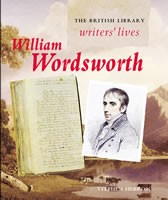 volume of poetry entitled Lyrical Ballads. At the time, the book did not make a huge splash in the English literary market place. Since then it has come to be seen as a watershed moment in the history of English poetry: the defining moment when the Age of Reason ended and the Romantic Age began.
volume of poetry entitled Lyrical Ballads. At the time, the book did not make a huge splash in the English literary market place. Since then it has come to be seen as a watershed moment in the history of English poetry: the defining moment when the Age of Reason ended and the Romantic Age began.
History, of course, does not move like that. Ages—to the extent that they ever exist as such at all—don’t end on any given Monday or with the publication of a single book. But looking back over the history of poetry, it’s clear that something has happened at the dawn of the 19th century that alters fundamentally and, it seems, permanently our understanding of poetry. The fundamental attitude toward poetry has changed so much that what passed as the highest poetic expression in the 18th century, something like Pope’s Essay on Man, would seem to miss the point if it were published in the 19th. We can see the difference in the subject matter of poetry, the theory of poetry (how people talk about poetry, what it is, where it comes from, what its job is in the world), and in the composition of poems.
From Craft to Art. To take the middle one first, we’ve not only made the move from intellectual to emotional truth, but we’ve made the decisive turn from craft to art.
This is a point we’ve seen before. Recall that the question of craft v. art first comes up in the Renaissance, when poets were first given names. That was when the notion of “artist” began to rise and “craftsman” began to all.
In the Enlightenment, Alexander Pope can confidently say that “True ease in writing comes from Art not Chance,” but at the same time tells poets (and anyone who wants to appreciate poetry) that the first step is to understand the ancient rules by studying the works of the Classic Greek and Roman writers. “Those rules [of poetry] of old, discovered, not devised, are Nature still [always] but Nature methodized.”
In the Romantic era, finally, the notion of craftsman slipped away almost completely from poetic thinking (though not from practice). Keats will famously say, Wordsworth responds to Pope-ish thinking by saying, “If poetry come not as naturally as leaves to a tree, it had better not come at all.” And Wordsworth will add:
Books! ’tis a dull and endless strife:
Come, hear the woodland linnet,
How sweet his music! on my life,
There’s more of wisdom in it.
If you are a poet it is because you are born a poet. You see the world as a poet sees the world. You experience the world through a poet’s eyes, even if you never write an actual poem. In practice, craft remains important (no one studied poetry more arduously than Keats did). But in thinking about poetry, it loses most of its importance.
The Poetic Imagination. Poetry comes from a deep source outside the poet, a source which is everywhere but which is not available to all people equally. The poet—a person of special genius—is, like a psychic medium, acutely aware of what the rest of us only dimly see about the true (in Romantic vocabulary the “sublime”) nature of things. The power the poet has in greater abundance than other people is in the imagination and the manifestation of the sublime is in the feelings.
In this era what is known as “nature poetry” reaches its highest expression. The poet uses his extraordinary imagination to perceive the sublime power of (or “in”) nature, which he or she drinks into his or her mind and passes back out in his life and in his poetry for the rest of us to experience.
The most common image for this process in Romantic poetry is that of the aeolian harp.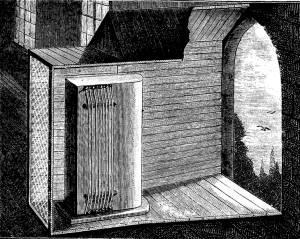
An aeolian harp is a stringed musical instrument that operates like a wind chime. When you place it in a window casement the wind plays the strings. Similarly, a poet, outdoors among trees and streams, feels in his mind the voice of Nature.
The writer of genius has the job of reconnecting the benighted people of this world with the essential and ideal world of nature that is invisible but all around them.[*] (In one of his best-known poems, Wordsworth recalls an ancient myth to suggest that this invisible world is the world from which we all came, which we left at birth: “Birth” he says, “is but a sleep and a forgetting”). The poet reveals to us or recalls us to that world. The Romantic poet is the “man of genius”; the Enlightenment poet would be the man of talent.
Coleridge distinguishes between genius and talent by saying that genius has the power “to represent familiar objects as to awaken in the minds of others a kindred feeling concerning them and that freshness of sensation which is the constant accompaniment of mental no less than of bodily, convalescence” (Biographia Literaria Chap. IV).
Coleridge
The power of genius is the strength of his or her imagination. “Imagination” is a fundamental word in the Romantic vocabulary. Like the word “Romantic” which, in this context, is not to be associated in any way with “love,” the word “imagination” is not to be associated with the ability to envision fairi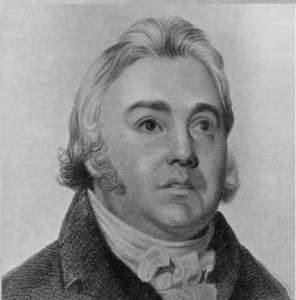 es and elves. It does not mean for the Romantics exactly what it means in common conversation today.
es and elves. It does not mean for the Romantics exactly what it means in common conversation today.
What is the imagination? It is a transcendent power we all have (though we don’t all make full use of it and we don’t all have the same amount of it); it is akin to but beyond all the physical senses and beyond all reason as well. It is the power by which truths are understood intuitively.
The imagination is the power that connects us not just with what is around us in the physical world but also with the invisible world. It is the thing within us that tells us what possess the quality of beauty or sublimity. It is the quality, in other words, that perceives in beautiful or sublime things the connection they have to the essential things. If there were angels walking among it, it would be the power we all have to sense that this is so, and the power by which a rare and gifted person (a poet) could tell on sight which were the angels and which the mere humans. This is because—whether primary or secondary—the poet’s imagination is beyond that of ordinary observers.
We ordinary people don’t really have imagination. What we have is “fancy.”[†] We can arrange the things we know and experience with our senses. But we can’t get at the higher things of the imagination—unless a poet helps us.
Poetry as Knowledge. In Romantic thinking, poets are individuals whose powers of synthesis are the highest. Poetry is not just a means of expression but a form of knowledge—and a form not merely equally valid (with science) but superior to science. Prophecy is an attribute of poetry. In the Renaissance, Philip Sidney had shown that poetry was considered prophetic by the Romans, but had never made the claim that prophecy was a species of poetry.
It is interesting to note that as the power and prestige of poetry are beginning to wane in the larger culture in the Romantic era (even as literacy and education in general rise and readers find novels and newspapers more to their liking) the claims for poetry become more inflated. In previous centuries poets and critics thought of poetry as an effect of thinking—putting thought into works. In the Romantic era poet Percy Shelley thought of poetry as thinking itself, the expression of the imagination. Sidney (back in the Renaissance) saw poetry as having a kind of propaganda value; Shelley sees poetry as the best lens to the most profound truth. The truth of poetry is truth itself.
Poetic form in the Romantic Era. For Romantic poets then this process of imaginative response to being becomes the most significant subject matter of their poems. Romantic poets would not think of putting a philosophical essay on man (as Pope does) into the form of poetry. Nor are they attracted to the heroic couplet, a mechanical verse form that requires nothing more than meticulous study of poetic figures and verbal effects. As we’ve seen, Romantic poets perceived poetry as coming organically to them from the world outside. Although it took a while, eventually Romantic poetry broke profoundly with traditional poetic forms. This is where the Americans enter the picture.
AMERICAN ROMANTICISM
Every poet mentioned so far has been an English poet of the early 19th Century. These were the poets who established the theory and practice of Romantic poetry in English. But they were read and studied by American poets. American Romanticism flowered a few decades later than English Romanticism. It is associated with poets such as Walt Whitman, Emily Dickinson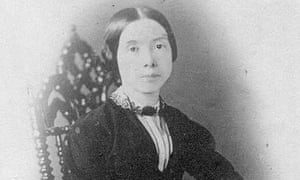 and Ralph Waldo Emerson (whose essays on nature and other Romantic subjects, along with his poetry, influenced the great American poets). Whitman and Dickinson added to Romantic thinking innovative poetics and verse forms.
and Ralph Waldo Emerson (whose essays on nature and other Romantic subjects, along with his poetry, influenced the great American poets). Whitman and Dickinson added to Romantic thinking innovative poetics and verse forms.
We’ve already seen several examples of Whitman’s long, unmetered lines. His poetic forms seem to expand organically. He is a creator of verse so original that William Dean Howells, a prominent literary critic of the time who was impressed by Whitman’s writing, could not bring himself to call what he wrote poems at all.
Dickinson, another poet we’ve often read, wrote in short stanzas based on the ballad quatrain. But her strange pauses (marked by long dashes) and aversion to true rhyme were no less innovative than Whitman’s lines.
Both poets explored Romantic ideas, which we can notice and discuss in this week’s discussion. But their greatest contribution to Romanticism may be their innovative poetics.
[*] This “ideal world of nature” must be distinguished from the everyday, visible world of nature, that is from trees and rocks, streams and oceans, clouds and rainbows. These visible forms are images of the ideal and invisible world of nature, which exists on a higher plain of reality. It is this “higher plane” that the Romantic poets are ultimately aiming for.
[†] It’s useful however to note that other Romantic poets, such as Keats, use the word “fancy” differently than Coleridge does. Keats “fancy” is a synonym for “imagination.” So when he writes “the fancy cannot cheat so well as she is famed to do,” he is referring to the highest power of power.
Video Lecture: The Romantic Era
Some Poems:
WIlliam Blake, “Holy Thursday [I.]” (Links to an external site.)
“Holy Thursday [II.]” (Links to an external site.)
William Wordsworth, from The Prelude “The Ascent of Mt. Snowdon” (Links to an external site.)
George Gordon, Lord Byron, “Darkness” (Links to an external site.)
John Keats, “Ode to a Nightingale” (Links to an external site.)
Samuel Taylor Coleridge, “The Eolian Harp” (Links to an external site.)
Percy Bysshe Shelley, “Ode to the West Wind” (Links to an external site.)
Ralph Waldo Emerson, “Brahma” (Links to an external site.)
Walt Whitman, “When I Heard the Learn’d Astronomer” (Links to an external site.)
Emily Dickinson, “I Taste a Liquor Never Brewed” (Links to an external site.)
“This Is My Letter to the World”
“The Bible Is an Antique Volume”
Gerard Manley Hopkins, “Spring and Fall”
